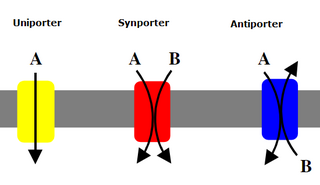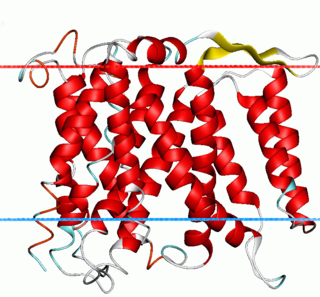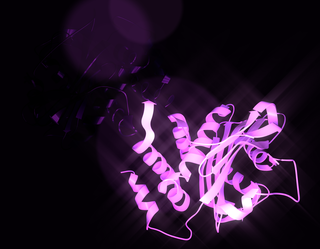Solute carrier family 9, subfamily B (NHA2, cation proton antiporter 2), member 2 is a protein that in humans is encoded by the SLC9B2 gene. [5]
Solute carrier family 9, subfamily B (NHA2, cation proton antiporter 2), member 2 is a protein that in humans is encoded by the SLC9B2 gene. [5]
Sodium–hydrogen antiporters, such as NHEDC2, convert the proton motive force established by the respiratory chain or the F1F0 mitochondrial ATPase into sodium gradients that drive other energy-requiring processes, transduce environmental signals into cell responses, or function in drug efflux. [6]

An antiporter (also called exchanger or counter-transporter) is a cotransporter and integral membrane protein involved in secondary active transport of two or more different molecules or ions across a phospholipid membrane such as the plasma membrane in opposite directions, one into the cell and one out of the cell. Na+/H+ antiporters have been reviewed.

Cotransporters are a subcategory of membrane transport proteins (transporters) that couple the favorable movement of one molecule with its concentration gradient and unfavorable movement of another molecule against its concentration gradient. They enable coupled or cotransport and include antiporters and symporters. In general, cotransporters consist of two out of the three classes of integral membrane proteins known as transporters that move molecules and ions across biomembranes. Uniporters are also transporters but move only one type of molecule down its concentration gradient and are not classified as cotransporters.

The sodium–hydrogen antiporter or sodium–proton exchanger (Na+/H+ exchanger) is a membrane protein that transports Na+ into the cell, and H+ out of the cell (antiport).

The sodium-hydrogen antiporter 1 (NHE-1) also known as sodium/hydrogen exchanger 1 or SLC9A1 is an isoform of sodium–hydrogen antiporter that in humans is encoded by the SLC9A1 gene.

Sodium–hydrogen antiporter 3 also known as sodium–hydrogen exchanger 3 (NHE3) or solute carrier family 9 member 3 (SLC9A3) is a protein that in humans is encoded by the SLC9A3 gene.

Sodium bicarbonate cotransporter 3 is a protein which in humans is encoded by the SLC4A7 gene.

Acid-sensing ion channel 1 (ASIC1) also known as amiloride-sensitive cation channel 2, neuronal (ACCN2) or brain sodium channel 2 (BNaC2) is a protein that in humans is encoded by the ASIC1 gene. The ASIC1 gene is one of the five paralogous genes that encode proteins that form trimeric acid-sensing ion channels (ASICs) in mammals. The cDNA of this gene was first cloned in 1996. The ASIC genes have splicing variants that encode different proteins that are called isoforms.

Concentrative nucleoside transporter 2 (CNT2) is a protein that in humans is encoded by the SLC28A2 gene.

Electroneutral sodium bicarbonate exchanger 1 is a protein that in humans is encoded by the SLC4A8 gene.

Multidrug and toxin extrusion protein 1 (MATE1), also known as solute carrier family 47 member 1, is a protein that in humans is encoded by the SLC47A1 gene. SLC47A1 belongs to the MATE family of transporters that are found in bacteria, archaea and eukaryotes.

Organic solute transporter alpha, also known as OST-alpha, is a protein which in humans is encoded by the SLC51A gene.

Sodium-dependent phosphate transporter 2 is a protein that in humans is encoded by the SLC20A2 gene.

Organic solute transporter beta, also known as OST-beta, is a protein which in humans is encoded by the OSTB gene.

Dock5, also known as DOCK5, is a large protein involved in intracellular signalling networks. It is a member of the DOCK-A subfamily of the DOCK family of guanine nucleotide exchange factors (GEFs) which function as activators of small G proteins. Dock5 is predicted to activate the small G protein Rac.

Solute carrier family 6, member 18 also known as SLC6A18 is a protein which in humans is encoded by the SLC6A18 gene.

Proton myo-inositol cotransporter, also known as solute carrier family 2 member 13 is a protein that in humans is encoded by the SLC2A13 gene.
The ion transporter (IT) superfamily is a superfamily of secondary carriers that transport charged substrates.

Na+/H+ antiporter A (NhaA) family (TC# 2.A.33) contains a number of bacterial sodium-proton antiporter (SPAP) proteins. These are integral membrane proteins that catalyse the exchange of H+ for Na+ in a manner that is highly pH dependent. Homologues have been sequenced from a number of bacteria and archaea. Prokaryotes possess multiple paralogues. A representative list of the proteins that belong to the NhaA family can be found in the Transporter Classification Database.
The NhaE family belongs to the Ion Transporter (IT) Superfamily, which has an end. A representative list of proteins belonging to the NhaE family can be found in the Transporter Classification Database.

The Monovalent Cation:Proton Antiporter-1 (CPA1) Family (TC# 2.A.36) is a large family of proteins derived from Gram-positive and Gram-negative bacteria, blue-green bacteria, archaea, yeast, plants and animals. The CPA1 family belongs to the VIC superfamily. Transporters from eukaryotes have been functionally characterized to catalyze Na+:H+ exchange. Their primary physiological functions are thought to be in (1) cytoplasmic pH regulation, extruding the H+ generated during metabolism, and (2) salt tolerance (in plants), due to Na+ uptake into vacuoles. Bacterial homologues have also been found to facilitate Na+:H+ antiport, but some also catalyze Li+:H+ antiport or Ca2+:H+ antiport under certain conditions.
This article incorporates text from the United States National Library of Medicine, which is in the public domain.